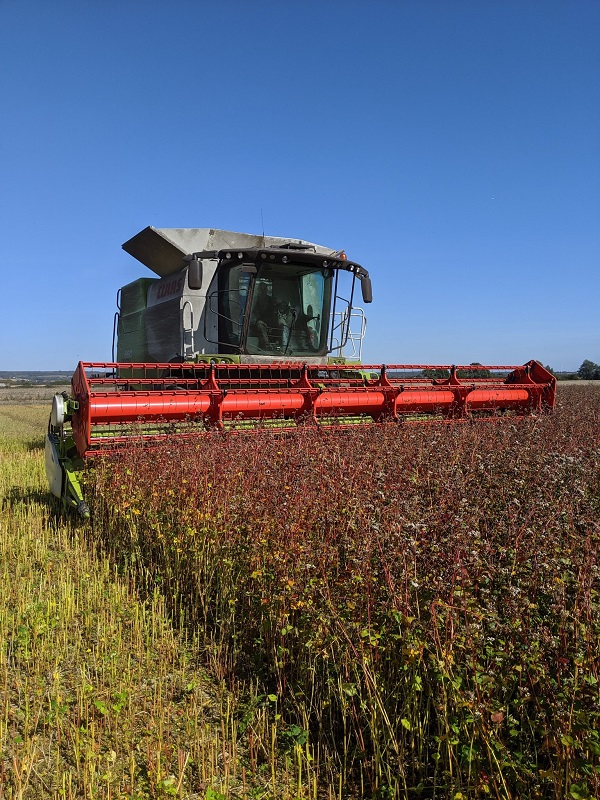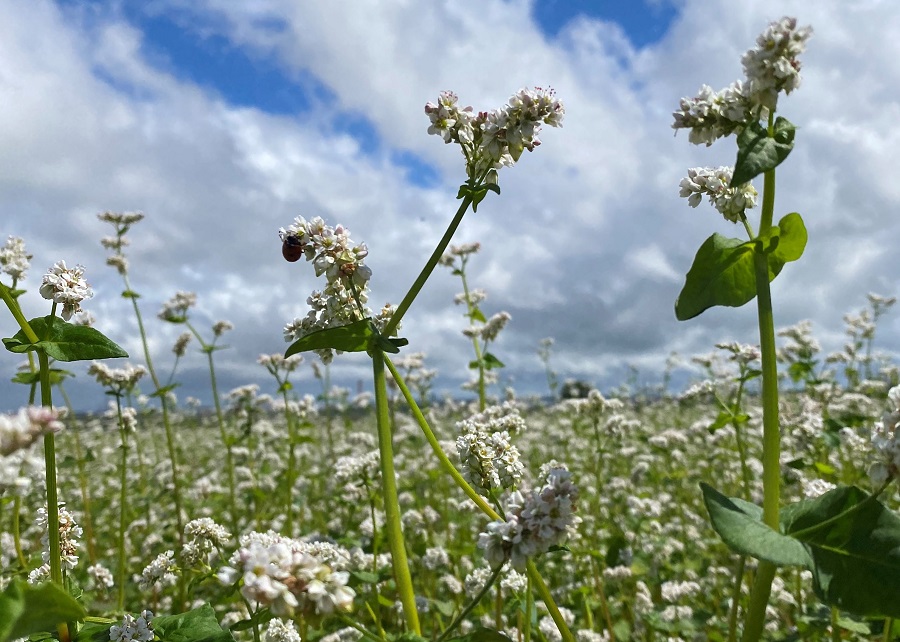The recent shake up to the rotation could be viewed an opportunity to re-evaluate crops on the farm and the way they’re marketed. CPM talks to a grower who is doing exactly this.
The story of OSR is a cautionary tale on monocropping.
By Lucy de la Pasture
For a large number of farms, the 2020 harvest marks the end of oilseed rape in the rotation. It’s been the break crop of preference for several decades, profitable when things go right but a total loss when things go wrong.
“OSR used to be cheap to grow, was relatively unaffected by pests and a high value break crop. Year after year it’s become a weaker link in the rotation,” says Niels Corfield, independent farms advisor and educator.

Buckwheat provides a summer-long display of flowers which ensure a valuable source of food for pollinators and a speciality grain for milling.
“The story of OSR is a cautionary tale on monocropping as we’ve somewhat witnessed the life and death of an industrial crop over four decades.”
Growers have two main routes where they’re left with a gap to fill in the rotation – either find a substitute crop, or diversify, he says. Which direction to head is a personal decision but Niels suggests the thinking process could begin with questioning the purpose OSR served on the farm. Was it primarily as an oil crop or a break crop?
He suggests industrial hemp as a potential candidate for substitution, with an emerging market for its fibre and oil. “Any crop can be good for the soil if it’s grown well but hemp ticks this box as well as being low input and with natural resistance to most pests.”
The seasons don’t match up for hemp and OSR and the licensing and market maturity in the UK are other potential stumbling blocks, he adds.
Mixed planting could be another route that growers could adopt to keep OSR, incorporating the seed into a three-way mix. It would be less likely to be attacked by CSFB and if the worst happened, then the other crop species would soon fill the gap the OSR plant leaves, he suggests.
“It’s a technique that’s already being used successfully with a mixture of milling wheat, heritage wheat and beans which are separated at harvest.”
Introducing herbal leys and diverse, full season cover crops opens up the possibility of bringing grazing animals back into arable enterprises, providing opportunities for graziers and added income to arable farms as well as the soil health benefits a well-managed grazing system can bring. But there are other benefits by making more grazing land available, including the superior nutritional quality of meat and animal by-products from grass-fed livestock, he highlights.
By changing field cropping practices and growing cover crops, Niels questions whether there’s still a need for a break crop in the rotation.
Essex farmer George Young believes the demise of OSR is an opportunity for farmers to think outside the box and move away from growing commodity crops. Recently nominated as an Arable Innovator in the British Farming Awards, 2020, George tends to turn conventional thinking on its head.
He’s convinced the future for farming is in producing fibres as well as food, so he is open to experimenting with unusual crops on the farm. His cropping currently includes hemp, buckwheat, linseed, lentils, millet and sunflowers alongside the more mainstream crops.
“Exceptional farms are very rare, with the vast majority of farmers having Grade 3 and 4 land with issues – in that scenario there’s not a lot of money being made. In my view that means if you do the maths properly and don’t just look at gross margin figures, there’s more room to experiment with small plots of other crops to get a feel for what will work on the farm.”
George is doing just this with his linseed this year. Linseed and flax are the same species – with linseed grown for its seed and flax for fibre – so he’s leaving a hectare as a fibre crop for an interested party. With the Fibreshed movement gaining momentum in the UK, this small experiment could become a fibre crop of the future, he believes.
Fibreshed is a system that originated in California and aims to build regional textile communities that enliven connection and ownership of ‘soil-to-soil’ textile processes – in essence that means compostable clothes, made and grown locally and without the use of artificial dyes.
“Generally farmers have the belief that you need an established market to grow for. I believe markets can be developed. How about when Apple released the iPad? Everyone laughed at them saying no one wants to use a tablet. Yet now most people have an iPad. Apple created a market where there wasn’t one. Farmers can do the same, but not if they have a poor attitude to change.”
George is setting out to develop new markets by engagement to create a much-shortened supply chain. “By doing this, more of the value will stay with the farmer. By just growing commodity crops for the diktat of ‘the market’, farmers will always be at the bottom rung of the ladder,” he comments.
It’s an attitude that could be considered naïve, yet George’s background indicates he may just know a thing or two about finances. His route into running the 486ha family farm hasn’t exactly been conventional.
“I had very little interest in farming when I was growing up and zero interest in driving a tractor, so I went down a different path. I studied mathematics at University, then became a semi-professional musician with aspirations to be a film editor before settling into a career in the City as a banker. Then seven years ago I came back to the farm.
“I didn’t enjoy farming as dad did it and I wanted to farm in a way that was better for nature. One of the first things I did was to move to zero till. It’s something I’m pleased I did but it hasn’t really moved things on much when it comes to farming with nature.”
Like many other growers this season OSR has been disastrous, with damage from cabbage stem flea beetle larvae meaning it had to be burnt off in March/April. “OSR had done quite well on the farm last harvest but we hadn’t grown it for the two years previously. Now I’m going to consider OSR in the same way as linseed – it will make sense in some years and not others.”
It wasn’t the only crop that didn’t go well this year, with both the millet and sunflowers crops failing due to lack of moisture in late spring. “April and May were very dry and the crops, drilled with a Cross Slot, just didn’t get away.”
In contrast the farm’s buckwheat has been flowering prolifically since May, providing pollinators with a source of nectar, and the hemp has grown well. It’s a crop George describes as ‘fascinating and necessary’, though the difficulties under the current system of Home Office licensing limits its potential in his opinion.
“The construction industry is heavily based on mining, but we could build solely using materials we can grow. Hemp can be used in hempcrete blocks, which have good thermal, acoustic and fire-retardant properties. Hemp oil from its seeds is also very nutritious.”
There’s an untapped potential for growing crops for seed and nut oils and he’s raising awareness about the better quality of food he believes us produced by a more artisan style of farming.
He highlights the mass-produced loaves produced in the UK as an example of highly processed food and compares that with the artisan bread baked on the continent. “It’s a very different system to Europe, where local mills provide local bakeries with local flour,” he explains.
The interest in breadmaking at home has surged during the COVID-19 pandemic, so artisan-produced flour could be another opportunity that wheat growers could capitalise on. George has ordered a stone mill from America to do just this and he will soon begin to produce speciality flour from his home-grown wheat and buckwheat.
He’s also planning on introducing agroforestry onto the farm this year. He has plans to square off a field and plant 6m strips of trees with 36m alleys for crops. Like many things George does, the planting will feature a slightly experimental combination of trees, as well as the more traditional timber plantings. These will include almond, olive, persimmon, peach and nectarine; white birch and silver birch for sap harvesting in time; apple and cobnut; willow whips; walnut, pear and fig; apple, apricot and gage; cob, damson and Mirabelle; apple, plum and cherry; and quince and plum.
In the mis-shapes that will make up the headlands, he is planning to plant trees and fruit bushes perpendicular to the forestry belts which will be pickable in their early years but also for nature.
“As time goes by the margins will become wild and allowed to regenerate naturally. By experimenting like this I hope to find a system that’s right for me while also being right for nature.”




